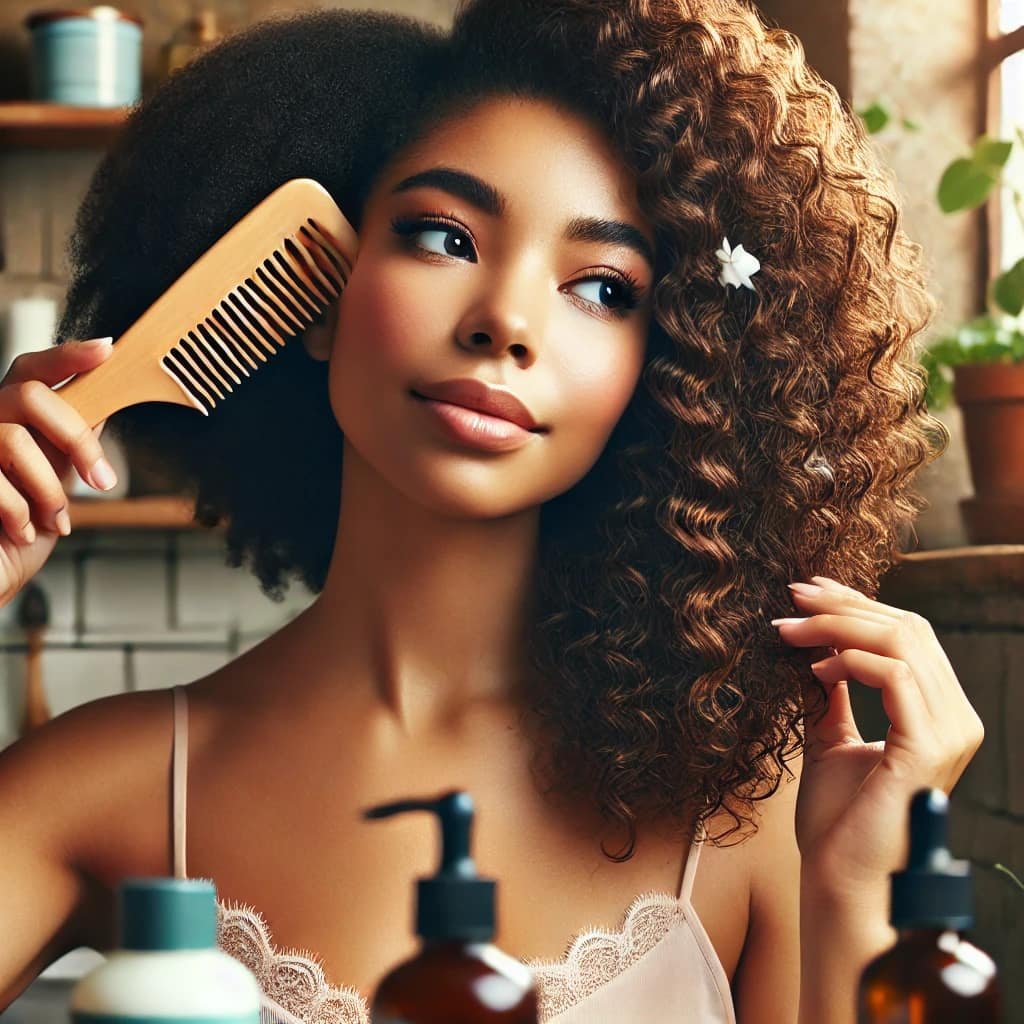Transitioning to natural 3C hair is a bold and beautiful decision. Embracing your natural texture allows you to regain the health and vitality of your hair. However, the road to natural 3C hair can be filled with challenges, especially if you’re unsure where to start. In this guide, we will explore every step of the transition process to make your journey smoother and more enjoyable.
Why Transition to Natural Hair?
Many individuals choose to transition to natural hair to embrace their natural beauty, avoid the harsh chemicals used in relaxers, or simply to experience the versatility of their natural curls. Whatever your reason, understanding the process and being prepared is key to a successful transition.
What Is 3C Hair?
Before diving into the transition process, it’s important to understand what 3C hair is. 3C hair is known for its tight curls that are about the size of a pencil. It tends to be dense, with lots of volume, and has a defined curl pattern. However, it can also be prone to dryness, so proper care is essential.
Understanding the Transition Process
What to Expect During the Transition
When you begin your transition to natural 3C hair, it’s essential to understand what to expect. Transitioning from relaxed hair can be a lengthy process, but with patience, your transition to natural 3C hair will be rewarding as you start to see your natural curls emerge.
Common Myths About Transitioning
There are several myths surrounding the transition process. One common myth is that you have to do a “big chop” to successfully transition. While some choose to cut off all their relaxed hair at once, others opt for a gradual approach. Another myth is that transitioning hair is difficult to manage. With the right care and products, managing two textures is completely achievable.
Preparing for the Transition
Setting Realistic Expectations
Before you start your transition, it’s important to set realistic expectations. Your hair won’t transform overnight, and there will be moments of frustration. Understanding that this is a journey will help you stay motivated and patient.
Gathering the Right Tools and Products
Having the right tools and products can make all the difference during your transition. You’ll need a good detangling brush, wide-tooth comb, satin scarf or bonnet for sleeping, and moisturizing hair products that cater to 3C curls.
Cutting Off the Relaxed Ends (Big Chop vs. Gradual Transition)
Deciding whether to do a big chop or gradually transition is a personal choice. The big chop involves cutting off all the relaxed hair at once, leaving only natural curls. While this can be liberating, it also means dealing with very short hair. A gradual transition allows you to maintain some length while slowly trimming away the relaxed ends.
Caring for Your Hair During Transition

Importance of Moisture and Hydration
Proper care is crucial when you transition to natural 3C hair. Focusing on moisture, protective styles, and avoiding heat damage will make your transition to natural 3C hair easier and help maintain the health of your growing curls.
Protective Hairstyles to Consider
Protective styles like braids, twists, and buns can help minimize manipulation and reduce the risk of breakage during your transition. These styles also make it easier to manage two different textures.
Avoiding Heat Damage
While it might be tempting to straighten your hair to blend the two textures, frequent heat styling can lead to damage and breakage. Instead, opt for heat-free styles that enhance your natural curl pattern.
Managing Two Textures
Managing two textures can be challenging, but it’s all about finding the right balance. Use gentle detangling techniques, and don’t rush the process. Applying products that provide slip can help make detangling easier and reduce breakage.
Essential Hair Care Routine
Shampooing and Conditioning Tips
Choose a sulfate-free shampoo that won’t strip your hair of its natural oils. Focus on cleansing your scalp, and follow up with a moisturizing conditioner. Consider co-washing (washing with conditioner) between shampoos to maintain moisture.
Deep Conditioning Treatments
Deep conditioning should be a regular part of your routine. Look for treatments that are rich in natural oils and butters to nourish and strengthen your curls. Apply heat to your deep conditioner to help it penetrate your hair shaft more effectively.
Detangling Techniques for 3C Hair
Detangling can be a tedious task, but it’s crucial for preventing breakage. Always detangle your hair when it’s wet and coated with conditioner. Start from the ends and work your way up to the roots, using a wide-tooth comb or your fingers.
Trimming and Maintaining Healthy Ends
Regular trims are essential to remove split ends and prevent breakage. Trimming every 6-8 weeks during your transition will help maintain the health of your hair and promote even growth.
Styling Tips for 3C Hair
Defining Your Curls
To achieve beautifully defined curls during your transition to natural 3C hair, it’s essential to use the right techniques and products. For more detailed guidance on styling and caring for your 3C curls, check out our comprehensive Essential Tips for Perfectly Defined 3C Hair: Care & Styling Guide. This article offers in-depth advice on everything from curl definition to maintaining healthy hair throughout your journey.
Low-Manipulation Hairstyles
Low-manipulation styles like twist-outs, braid-outs, and wash-and-go’s are perfect for transitioning hair. These styles help define your curls without requiring too much effort or causing unnecessary tension on your hair.
Nighttime Hair Care Routine
At night, protect your curls by wrapping your hair in a satin scarf or bonnet. You can also use a satin pillowcase to reduce friction while you sleep, preventing frizz and breakage.
How to Protect Your Hair While Sleeping
Sleeping with your hair loose can lead to tangles and breakage. Consider putting your hair in a loose pineapple (a high ponytail) to maintain your curls’ shape and protect your ends.
Product Recommendations
Best Shampoos and Conditioners for 3C Hair
Finding the right products is crucial when you transition to natural 3C hair. From shampoos and conditioners to leave-in treatments, the products you use can make a significant difference in the health and appearance of your curls. For a curated list of the best products to enhance your 3C curls, check out our Top 10 Must-Have Products for 3C Hair: Enhance Your Curls. This guide provides recommendations that can help you maintain beautifully defined and healthy curls throughout your journey.
Leave-In Conditioners and Moisturizers
Leave-in conditioners are a must for 3C hair. They provide an extra layer of moisture and help define your curls. Opt for products that are lightweight yet hydrating to avoid weighing down your hair.
Oils and Serums for Scalp Health
Oils like jojoba, argan, and castor oil are great for maintaining scalp health and promoting hair growth. Massage these oils into your scalp regularly to nourish your hair follicles and encourage healthy growth.
Recommended Styling Products
For styling, gels and creams that enhance curl definition and provide hold are ideal. Look for products that are alcohol-free to avoid drying out your hair.
Dealing with Setbacks
Overcoming Breakage and Split Ends
Breakage and split ends are common during the transition process. To minimize them, ensure your hair is always well-moisturized, avoid excessive manipulation, and trim your ends regularly.
What to Do When Your Hair Feels Dry and Brittle
If your hair feels dry and brittle, it’s a sign that it needs more moisture. Incorporate more deep conditioning treatments into your routine, and consider using a hydrating hair mask once a week.
Staying Motivated During the Transition
Transitioning to natural 3C hair can be a long and sometimes challenging journey, but staying motivated is key to your success. Connecting with others who are going through the same process can be incredibly encouraging. Join discussions and find support on the r/NaturalHair subreddit where thousands of people share their experiences, tips, and encouragement for maintaining natural hair.
Maintaining Your Natural 3C Hair
Embracing Your Curls Post-Transition
After you’ve successfully completed your transition to natural 3C hair, maintaining your curls becomes the next focus. Continuing to nourish and protect your hair will ensure that your transition to natural 3C hair results in long-lasting, healthy curls.
Long-Term Hair Goals
Set long-term goals for your natural hair journey, whether it’s achieving a certain length, mastering a particular hairstyle, or maintaining overall hair health. Having goals will keep you focused and motivated.
Celebrating Your Natural Hair Journey
Don’t forget to celebrate your progress! Transitioning is a significant achievement, and you deserve to enjoy every step of the way. Treat yourself to a new hairstyle, a photo shoot, or even a spa day to commemorate your journey.
Conclusion
Transitioning from relaxed to natural 3C hair is a journey that requires patience, care, and dedication. By following the steps outlined in this guide, you can make the process smoother and more enjoyable. Remember to embrace each phase of your transition and take pride in your natural curls. Your hair is a reflection of your unique beauty, and the effort you put into caring for it will be well worth it in the end.
FAQs
1. How long does it take to transition from relaxed to natural 3C hair?
The transition process can take anywhere from several months to over a year, depending on your hair’s growth rate and how frequently you trim the relaxed ends.
2. Can I transition without doing the big chop?
Yes, you can transition without doing the big chop by gradually trimming away the relaxed ends over time.
3. What is the best way to manage two different hair textures during the transition?
Managing two textures can be challenging, but protective styles, regular deep conditioning, and gentle detangling can help make the process easier.
4. How often should I trim my hair during the transition?
Trimming every 6-8 weeks is recommended to remove split ends and maintain healthy hair during the transition.
5. Are there any protective styles that can help speed up the transition?
Protective styles like braids, twists, and buns can help protect your hair and reduce manipulation, which may help speed up the transition process.


1 Comment